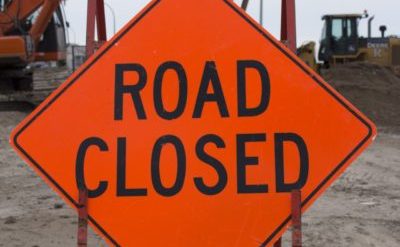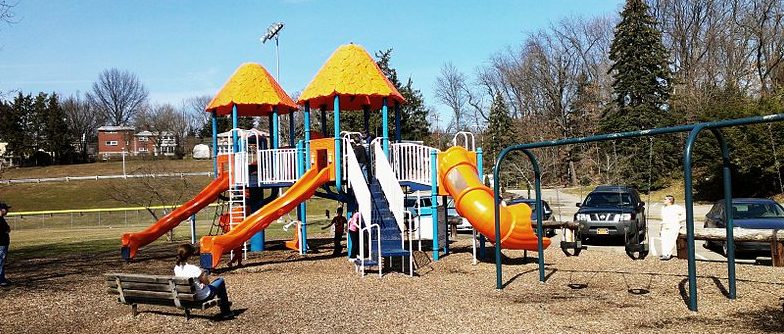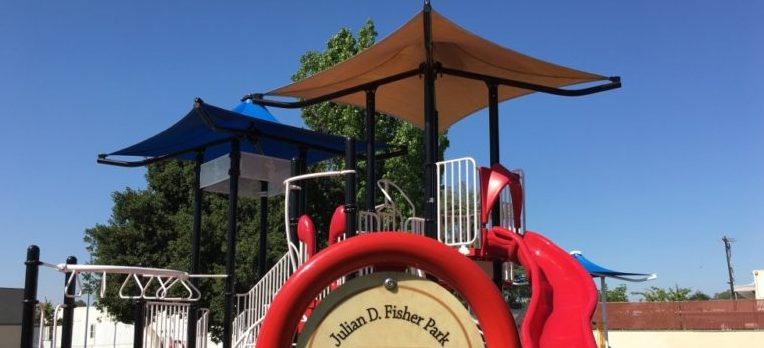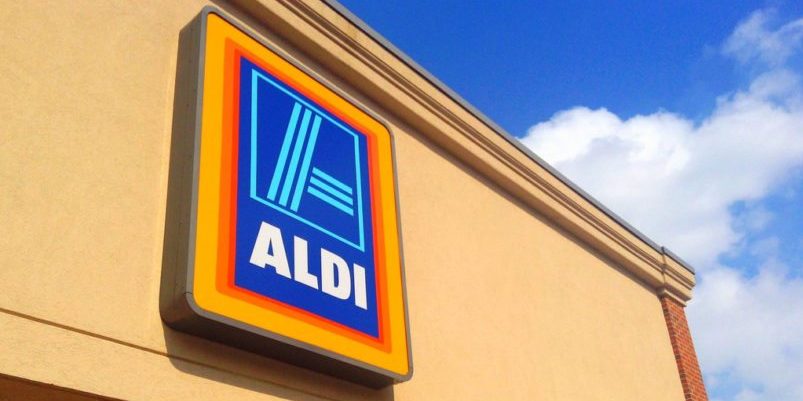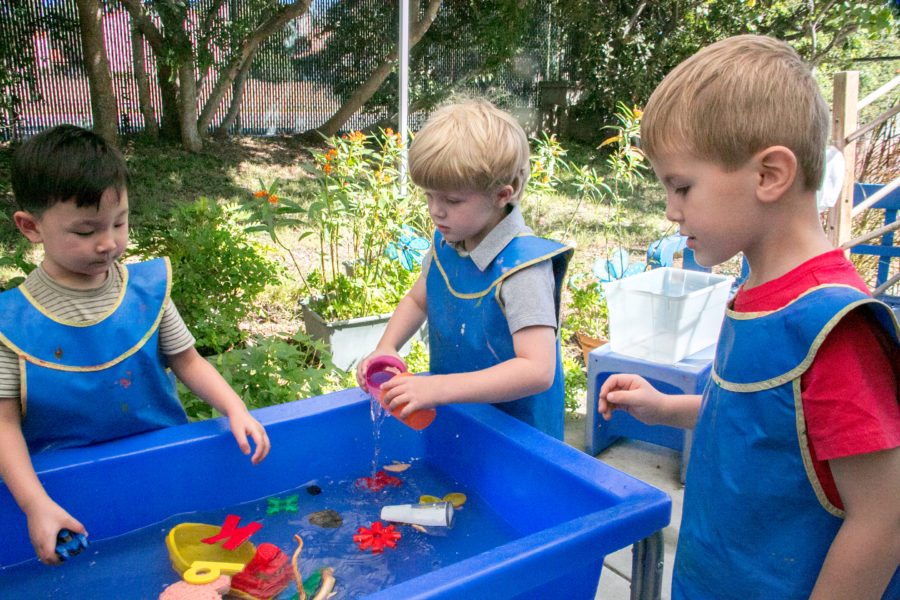
By May S. Ruiz
One evening this past October, little students were all gathered impatiently around a rain gutter filled with water, eager to sail their “boats” down the river. This was going to be so much fun!
That they’re three-, four-, and five-year-old pre-school and kindergarten students at Clairbourn School, an independent junior pre-K to eighth grade school in San Gabriel, learning STEM was why this regatta was such a big deal.
What was totally out of character, though, was how even the parents couldn’t take their hands off the boats. They were just as enthusiastic to test the product they built with their children.
This was the culmination of a ten-day, three-part STEM Regatta project that began with the teacher reading ‘The Raft’, by Jim La Marche, a story about a little boy who spends the summer with his grandma in her cabin. The classes also read ‘The Three Billy Goats Gruff’, about a family of goats that wants to avoid the troll and cross a river.
After listening to the stories, students were challenged to design and build a miniature boat, or raft, capable of carrying three billy goats (represented by three small, but heavy metal washers) to avoid a dangerous troll. Their boat/raft should not exceed five inches wide, and had to be able to float.
The first part – raft/boat component – took five days to complete. Day one was reading the story. The second day was spent researching with Nearpod presentation and time for questions. On day three students tested their materials and charted their findings. Using their selected materials, they planned and designed their raft on the fourth day. Day five was spent building their designs. On day six they tested their designs, made improvements and retested.
The second part – the sail component – was done in three days. The class read books about the wind on the seventh day. They spent the eighth day listening to a Nearpod presentation to learn about sails. On day nine students investigated sail materials, sizes, and shapes with demonstrations and charted their results.
The third part – the finale event – was the STEM regatta. On Thursday, October 5, 2017, all three grades, made up of two pre-kindergarten classes and one kindergarten class, and their parents came to Clairbourn for the crucial finish.
The evening’s activity consisted of extensive display boards and a Nearpod presentation from kindergarten teacher, Kris Shoemake, to show parents their children’s learning process over the previous nine days.
And then it was time for families to build the sails, followed immediately by wind-powered boat/raft races by grade level.
Karen Paciorek, Lower School Director, says the STEM regatta was the collaborative brainchild of the pre-school, kindergarten teachers and herself. She relates, “We’ve been wanting to do a cross-grade activity that highlights the things they do all the time in their classrooms with ‘Project Work’. They brainstormed, agreed on an idea and decided on a title. It was a collaborative effort for the teachers, which is a model for what we want students to emulate.
The idea for the regatta came organically. Kris Shoemake came across an article about students testing boats. Since we know that kids love playing with water, we thought that would be a fun way for kids to learn the concepts of floating and sinking. Instead of us showing pictures, we’d take it a step further by having a hands-on activity integrating what they do in the upper grade engineering design challenge.
We wanted for them to show their learning by picking what materials would work for them. We also wanted this project to demonstrate to parents the progression of ability through the grades – expectations at JPK (junior pre-kindergarten), PK (pre-kindergarten), and at K (kindergarten) – so they have a true picture of what we look at as developmentally appropriate.
Teachers use the academic language with the kids so even the youngest students know this is a science project. We’re not expecting them to master the concepts or terms, but to be familiar with them. They will be hearing the words as they go through the grades.”

Adds Dr. Amy Patzlaff, Assistant head of School, “It wasn’t merely a reinforcement of the concept of buoyancy. Teachers talked about the scientific methods: collecting, charting, and interpreting data. As the students worked and tested a variety of materials, they had a chart that showed which boat sank and which floated so they could refer to the data later. And it was simple – it was pre-school level – but they could see on the chart which material worked and didn’t.
They then repeated it when they were talking about sails – which materials held against the wind? Did the shape matter? The students tested the sails using a zip line and a fan; they sat and watched as they tried different things. They had access to that data as well when they had to replicate the activity on the night of the regatta. They built their sails with their parents and tested their final product. They employed scientific methods – how to use the data; how to problem-solve; how to use previous history to scaffold what’s going to happen next; how to use the product for the next round.
Each grade level had a different take on building the boat, which was all done in the classroom, with the teacher assisting. During the night of the regatta, the parents helped in the culmination of the activity which was building the sail and testing it.
To make it age appropriate, it wasn’t a win-lose situation; they just wanted to see if it worked or if it didn’t, and why. We used water-filled rain gutter rivers with a fan at the end. They set their boat in the rain gutter and if the boat got stuck, they righted it. Watching the parents test their product was highly entertaining! But it was all a friendly event, everyone cheered for one another, happy to see each other succeed.”
According to Paciorek, even during the ten-day period that the kids were working on it, they would practice what they learned at school. Her granddaughter, who is four-years-old and is in the pre-K class, tested some toys for buoyancy in their bathtub.
“This is fairly representative,” explains Dr. Patzlaff. “When I was having breakfast with some of the parents later that week many parents commented on their kids wanting a fan to test the zip line of some of the sail types, in addition to the ones provided in class. Another child wanted to get more materials to test in their bathtub at home; one was going to do a race in their pool. So they wanted to continue the exploration and testing on their own. It continued to engage them which is a great testament to the fun embedded in the project.”
Paciorek says the regatta was a major collaborative event and they plan to do one every year. In the meantime, each grade has its own classroom STEM projects. In kindergarten they have about four or five smaller STEM-related work. One is an apple-picking activity where kids help a farmer get his apples from the trees to the barn. Students have to design the transportation to get this accomplished using the same scientific methods.
In first grade they do a pumpkin drop and students have to brainstorm ideas in groups and design a container that protects the pumpkin. They test which materials kept the pumpkin from breaking. They also have one activity where they build a nest to hold the eggs.
“We started a heavy emphasis on STEM once the NGSS (Next Generation Science Standards), the nationally adopted science standards, came into play around 2012,” states Dr. Patzlaff. “There has been so much conversation about 21st century skills and about not knowing what jobs are going to look like. And because we don’t know what jobs are going to look like the most important pieces we can give students are how to problem-solve, how to think, how to communicate clearly, how to have resilience and grit, how to persevere when something doesn’t go right, collaborating – all the soft skills – in addition to being able to write.
One thing that STEM projects give is real-world possibilities for how to apply those skills in a nice, tight package. When they design the sail for the boat, for instance, they have to problem solve, they have to work together, they have to communicate with their partner, they have to be able to document their results. For little kids documentation is different – we take a picture of it and we put them on the wall. For older kids, they would be written documentation of some sort, depending on the age. It gives them opportunities to apply the skills in ways that are highly engaging and meaningful to them so they’ll want to persist in it.
Having STEM in our curriculum not only improved math skills and scores among our students, it has also helped primarily in the understanding of concepts. We want kids to not rely on memorization of formula because if they memorize it incorrectly they will never get the right answer. If all they know is the formula, they’re only plugging in numbers; they aren’t checking it to see if that makes sense because they don’t have a way to do that.”
Paciorek adds, “Through this program they’re learning to explain what they’re doing and why they’re doing it. That gives them that foundational understanding to gain higher performance in math, even at the kindergarten level.”
“I think parents now are looking for things that are measurable,” Dr. Patzlaff posits. “It’s hard to test for creativity and that’s one of my biggest challenges. Frankly, the things that are easily measured like the Kumon math worksheets – my kids could do 100 additional problems in 45 seconds – don’t really mean much. What are you going to do with that? Being able to blend the measurable outcomes with the applicable results is an interesting thing for me. The things that I value are the problem-solving, the communication, the ability to work together with others, the ethics – most of those things are hard to measure.
The components that are within STEM – the problem-solving, the engineering, the applicability of all the new skills – they’re all important competencies to add on but how do you apply them? I like the elements of STEM that help give context to student learning. It gives more meaning to the concept so it sticks and makes them want to explore further.”
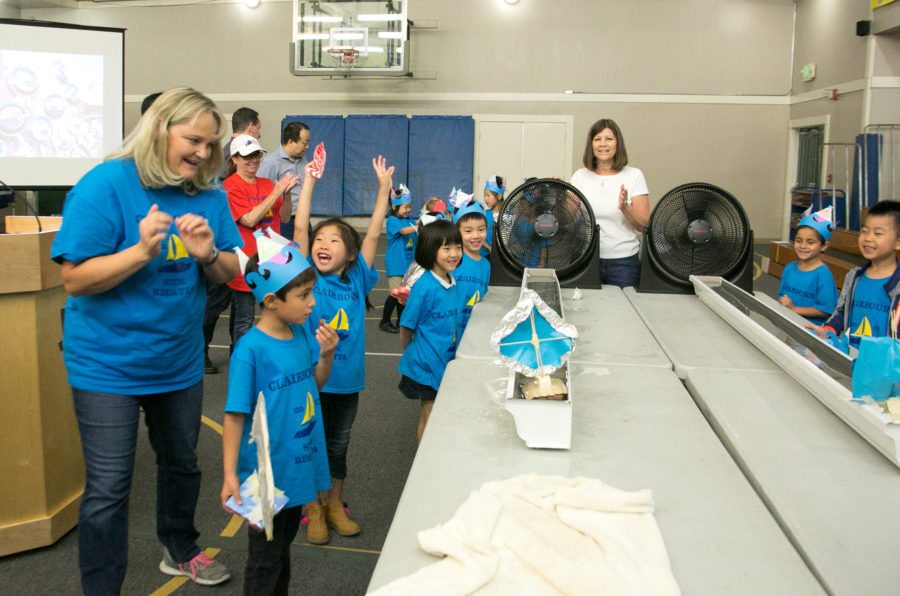
Concurs Paciorek, “They don’t really see it as learning, it’s just something fun and interesting for them. Another thing that’s vital that we discuss with parents is that high schools and colleges are looking for balanced students. When we have standardized testing appointments with individual parents we’re educating them, one family at a time, on the importance of being well-rounded. We explain that these tests only measure Language arts and math; they don’t measure sense of humor, leadership skills, musical ability – all those things that are key in making well-rounded people.
The high schools love our students, they add so much to the schools they go to and this is where they get that foundation. We want families to understand that. It’s not just about math or science; it’s learning how to apply the academics, how to think, how to be creative.”
According to headmaster, Dr. Robert Nafie, Clairbourn’s overall teaching philosophy mirrored that of other English-based schools, which focused on a classical liberal arts education. However, as times changed the school shifted its emphasis to keep up with prevailing conditions.
“The world has gotten smaller and the population is much more diverse,” begins Dr. Nafie. “Our students are global citizens, they come from different backgrounds and culture. As such, the language becomes a little less precise, less critical even. Today’s universal language is mathematics and the hard sciences are the currency to become successful.
The big question for schools now is ‘Do we prepare our students for their future or for our past?’ We’re more comfortable preparing them for our past because we were educated that way, we know it. But the truth is we have to look into that murky, cloudy, and foggy future.
That said, from Clairbourn’s standpoint, we have always done a good deal of STEM. We’ve had a lower school science lab for at least 25 years where teachers have all workbook activities, and experiment materials, and tools organized for them in the cupboards.”
“We are in an educational and biotech corridor,” Dr. Nafie points out. “This particular area of Los Angeles is very rich in science and technology. Starting on the west side, with UCLA, USC, Pepperdine; in Pasadena we have Caltech and JPL. We have all these hospitals – Huntington Memorial, Arcadia Methodist, City of Hope. These institutions are, really, right along the mountains going all the way east to the Claremont Colleges.
Our feeling is that there should be an ongoing conversation between Clairbourn and the community. Several years ago we started something called Project STAR (Science, Technology Activities, and Research) and invited our Caltech dads for input on how we can focus on engineering and science. As a result of that, we held science fairs with Caltech and JPL engineers as judges, and we had a guest speaker. In recent years, we have embraced STEM as a philosophy. We established an Entrepreneurial Fair where there are Makers’ Spaces for students to create something creative using STEM.
For Clairbourn, the reality is that we are in the midst of a very large Asian population. Our families are from Arcadia, Pasadena, San Gabriel, San Marino, and Temple City. And what they’re looking for is a school that has a strong emphasis on STEM. At the end of the day we are a corporation masquerading as a school. If we don’t provide what people want, we’ll be out of business.
We have to ensure that children in the youngest grades have this kind of educational experiences. We teach STEM early and we use the spiral curriculum – we introduce a subject and come around to it again. For instance, we teach fractions in second grade, hit it hard in fourth, reinforce it in sixth, etc. For STEM we introduce it through activities like the regatta but that won’t be the last they will hear about it.”
Ultimately, what matters is what children make of their education. As Dr. Patzlaff says, “More than anything, I want to send out into the world students who could think and problem-solve. That’s what’s needed right now because there are so many vexing problems and the solutions aren’t that obvious. Because if they were, we would’ve already solved them.”
These three-year-olds are our best hope for a brighter future. That’s why Clairbourn is teaching and training its youngest students to identify challenges and resolve them using the lessons they learned in class. And if they have to get their hands in the water in order to do that, then it would be worth the trouble. Or the fun.

